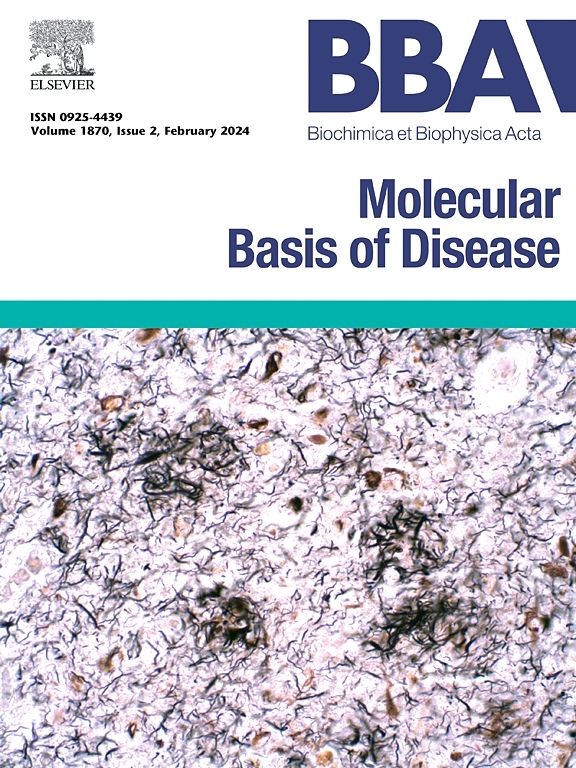CTLA4调节B细胞受体信号抑制慢性乙型肝炎患者HBsAb分泌
IF 4.2
2区 生物学
Q2 BIOCHEMISTRY & MOLECULAR BIOLOGY
Biochimica et biophysica acta. Molecular basis of disease
Pub Date : 2025-04-24
DOI:10.1016/j.bbadis.2025.167848
引用次数: 0
摘要
修复B细胞缺陷对于实现慢性乙型肝炎病毒(CHB)感染的功能性治愈至关重要,但具体的靶点在很大程度上仍未被探索。我们的研究发现,CTLA4在CHB患者的外周和肝脏HBsAg特异性B细胞中都高度上调,而有效的聚乙二醇干扰素-α治疗可以降低CTLA4+HBsAg+ B细胞的频率。单细胞RNA-seq分析显示,CHB患者记忆B细胞中IL-6 JAK/STAT3和IL-2/STAT5信号通路减少,这可能是导致HBsAb抗体分泌能力丧失的原因。与CTLA4 - B细胞相比,CTLA4+ B细胞,特别是来自慢性乙型肝炎患者的CTLA4+ B细胞在B细胞受体信号传导和炎症反应中始终表现出缺陷反应。值得注意的是,CTLA4缺失在体外部分恢复了CHB患者外周B细胞的HBsAb分泌,但也可以恢复HBV小鼠模型中的抗hbs体液反应并增强病毒清除。机制分析显示,CTLA4直接与SHP-1结合,导致Jak-STAT和B细胞受体信号通路受损。总的来说,我们的数据强调了CTLA4在B细胞反应中的作用。靶向B细胞的CTLA4有望实现慢性乙型肝炎患者的功能性治愈。本文章由计算机程序翻译,如有差异,请以英文原文为准。

CTLA4 modulates B cell receptor signals to inhibit HBsAb secretion in chronic hepatitis B patients
Restoring B cell defects is crucial to achieve the functional cure of chronic hepatitis B virus (CHB) infection, yet the specific targets remain largely unexplored. Our study identified that CTLA4 was highly upregulated in both peripheral and hepatic HBsAg-specific B cells from CHB patients, while effective peginterferon-α treatment could reduce the frequency of CTLA4+HBsAg+ B cells. Single-cell RNA-seq analysis revealed that the diminished IL-6 JAK/STAT3 and IL-2/STAT5 signaling pathways in memory B cells from CHB patients,which might contribute to the incapability of HBsAb antibody secretion. CTLA4+ B cells, especially from CHB patients, consistently showed defective responses in B cell receptor signaling and inflammatory responses compared to CTLA4− B cells. Notably, CTLA4 depletion partially restored the secretion of HBsAb in vitro from peripheral B cells from CHB patients, but also could restore anti-HBs humoral responses and potentiate viral clearance in HBV mouse model. Mechanistic analysis revealed that CTLA4 is directly bound to SHP-1, resulting in the impaired Jak-STAT and B cell receptor signaling pathway. Collectively, our data highlights an unappreciated role of CTLA4 on B cell responses. Targeting CTLA4 on B cells holds promise to achieve the functional cure of CHB patients.
求助全文
通过发布文献求助,成功后即可免费获取论文全文。
去求助
来源期刊
CiteScore
12.30
自引率
0.00%
发文量
218
审稿时长
32 days
期刊介绍:
BBA Molecular Basis of Disease addresses the biochemistry and molecular genetics of disease processes and models of human disease. This journal covers aspects of aging, cancer, metabolic-, neurological-, and immunological-based disease. Manuscripts focused on using animal models to elucidate biochemical and mechanistic insight in each of these conditions, are particularly encouraged. Manuscripts should emphasize the underlying mechanisms of disease pathways and provide novel contributions to the understanding and/or treatment of these disorders. Highly descriptive and method development submissions may be declined without full review. The submission of uninvited reviews to BBA - Molecular Basis of Disease is strongly discouraged, and any such uninvited review should be accompanied by a coverletter outlining the compelling reasons why the review should be considered.

 求助内容:
求助内容: 应助结果提醒方式:
应助结果提醒方式:


